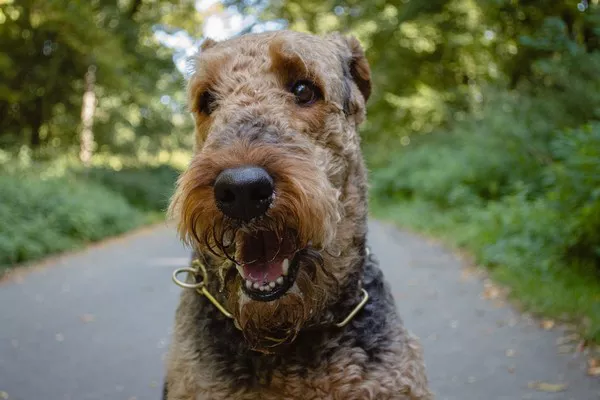The Airedale Terrier, often called the “King of Terriers,” is a distinctive and impressive breed. Known for its versatility and elegance, the Airedale has a unique appearance that sets it apart from other breeds. This article explores the physical characteristics of the Airedale Terrier in detail, covering its size, coat, color, and overall appearance.
General Appearance
The Airedale Terrier is the largest of the terrier breeds, known for its commanding presence and sturdy build. It combines strength with a refined elegance, giving it a distinguished and balanced look.
Size and Build
Height
Description: Adult Airedales typically stand between 21 to 23 inches at the shoulder.
Purpose: This height gives them a balanced and imposing stance.
Weight
Description: They usually weigh between 40 to 65 pounds.
Purpose: Their weight complements their height, contributing to their robust and solid appearance.
Body Structure
Description: The Airedale has a long, deep chest and a strong, muscular build. Its back is straight and level, and it has a well-defined waist.
Purpose: This structure supports their agility and strength.
Legs and Feet
Description: They have straight, strong legs with compact, oval-shaped feet.
Purpose: Their legs and feet provide stability and endurance, crucial for their historical role as working dogs.
Head and Expression
Head Shape
Description: The Airedale’s head is long and flat, with a moderate stop.
Purpose: This head shape contributes to their distinctive and alert expression.
Eyes
Description: Their eyes are medium-sized, dark, and almond-shaped.
Purpose: They give the Airedale a keen and intelligent expression.
Ears
Description: The ears are V-shaped, set high on the head, and fold forward.
Purpose: Their ear shape adds to their alert and expressive look.
Muzzle and Nose
Description: The muzzle is long and strong, with a black nose.
Purpose: The length and strength of the muzzle contribute to their powerful bite and keen sense of smell.
Coat and Color
Coat Type
Description: The Airedale has a dense, wiry outer coat with a soft undercoat.
Purpose: This coat type helps protect them from various weather conditions and is ideal for their historical working roles.
Coat Length
Description: The coat is medium in length, standing off the body.
Purpose: The length ensures that the coat is functional and practical for both working and show purposes.
Coat Color
Description: The Airedale’s coat is typically a rich tan with a black saddle.
Purpose: This coloration highlights their distinctive appearance and is a key feature in breed recognition.
Grooming Needs
Description: Regular brushing is needed to maintain the coat’s texture and appearance. They also require periodic hand-stripping to maintain their wiry coat.
Purpose: Proper grooming ensures the coat remains healthy and maintains its characteristic look.
Tail and Gait
Tail
Description: The tail is medium in length, carried high and slightly curved.
Purpose: The tail’s carriage is a hallmark of the breed’s confident and alert demeanor.
Gait
Description: The Airedale moves with a smooth, flowing gait. Their stride is long and effortless.
Purpose: Their gait reflects their strength and agility, essential for their historical roles.
Temperament Reflected in Appearance
The Airedale Terrier’s appearance reflects its temperament. They are known for their intelligence, courage, and loyalty. Their confident stance and alert expression convey their readiness for action and their strong character.
Comparison with Similar Breeds
Compared to the Welsh Terrier
Description: The Welsh Terrier is smaller, with a more compact build compared to the Airedale. The Airedale’s size and coat distinguish it as the largest terrier breed.
Compared to the Scottish Terrier
Description: The Scottish Terrier has a shorter, more compact body and a different coat texture. The Airedale’s larger size and longer legs set it apart.
Compared to the Bedlington Terrier
Description: The Bedlington Terrier has a unique, lamb-like appearance with a soft, curly coat. The Airedale’s wiry coat and larger size differentiate it from the Bedlington.
Historical Context of the Airedale’s Appearance
The Airedale Terrier originated in the Aire Valley of Yorkshire, England. Originally bred for hunting and as a working dog, their appearance was developed to combine strength, agility, and endurance. Their distinctive look was practical for their roles as versatile working dogs, capable of tackling various tasks from hunting to guarding.
Health and Physical Considerations
Common Health Issues
Description: Airedales may be prone to conditions like hip dysplasia and certain skin conditions.
Purpose: Understanding these issues helps in maintaining their health and well-being.
Maintaining Appearance
Description: Regular vet check-ups and a proper diet contribute to their overall health and appearance.
Purpose: Ensures the Airedale remains in good condition and maintains its characteristic look.
See also:How to Train an Aussiedoodle
Conclusion
The Airedale Terrier is a striking breed with a unique appearance characterized by its size, coat, and overall demeanor. Understanding their physical traits helps appreciate their beauty and functionality. Whether as a working dog or a beloved family companion, the Airedale’s appearance reflects its rich history and versatile nature.
Maintaining their distinctive look requires regular grooming and attention to health. By understanding and caring for their physical needs, you can ensure that your Airedale Terrier remains both healthy and handsome, embodying the essence of this remarkable breed.
Related topics:


